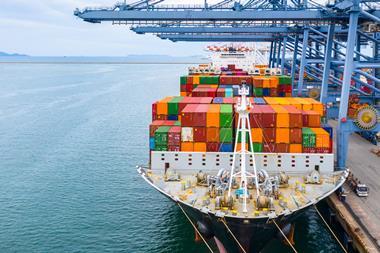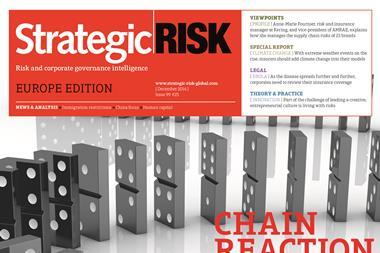We now live in a world where the largest shoe producers do not actually make footwear, but only design and market it. A world where the largest direct seller of personal computers assembles them from components sourced elsewhere. In one industry after another supply chains stretch farther than they ever have in the past, just when lean, just-in-time production schedules have made the consequences of a break more severe.
With operations scattered around the globe, companies face a host of new perils: political and currency risks, cyber attacks, failed communications, just-in-time delivery strategies. They face dramatic, unpredictable risks associated with terrorism. But they also still face traditional property-related risks to their supply chains, such as fire, natural disaster, power-grid blackouts and equipment breakdowns.
In fact, financial executives around the world have identified supply chain risk as having the greatest potential to disrupt their top revenue driver, according to a recent study, Managing Business Risks in 2006 and Beyond,conducted by FM Global (download from www.protectingvalue.com ).
Companies need not accept these new supply chain risks as insurmountable, to be guarded against simply by purchasing larger insurance policies. Indeed, while some view insurance as a primary component of supply chain risk management, it more properly functions as a last line of defence.
One of the most effective ways to manage supply chain risks is to keep them from happening. The challenge today is to extend that effort to a supply chain that may stretch around the globe and include a vast array of independent suppliers, shippers and other vendors over whom your company has no direct control and which, in every instance, add a new layer of risk to your supply chain.
It is possible. It begins with taking the time to identify key products, revenue drivers, core business processes and locations in the supply chain - from procurement of raw materials to delivery of finished goods - as well as the types of events that could disrupt them. Then, take steps to prevent these 'pinch points' from squeezing shut.
Think, for example, of the way companies have traditionally sought out locations for manufacturing facilities. In addition to taking into consideration the availability of an adequate labour force and reasonable proximity to raw materials and customers, companies favoured sites that were not exposed to flooding or storms, had good access to transportation networks, and were in countries with stable governments and reliable legal systems.
Today, companies that are looking to add a supplier partner, or outsource manufacturing to a third party can apply the same standards when deciding where to look for them. Similarly, if companies follow strict safety standards in their own facilities, they can choose suppliers that do the same. If your business is important enough to a supplier, that provider even may allow you to audit its facilities or agree to make safety or security changes to achieve preferred supplier status. Companies that are truly committed to this process sometimes go so far as to look at the suppliers of their suppliers.
Unfortunately, many companies rush to revamp their supply chains without giving much thought to such measures. As they outsource to developing countries, they often unknowingly take on greater exposure to natural disasters, lower safety standards and less reliable legal systems. The message is not that companies should never outsource to developing, high-exposure territories, but rather, that companies can help themselves by factoring the existing risks into the decision-making process and weigh those risks against the potential rewards. Then, where the risks are deemed unacceptable, look for ways to prevent or control them.
That said, it would be a mistake to focus only on trying to manage catastrophic supply chain disruptions. While a major disaster can wipe out a company or product line, so too can a series of minor disruptions. If companies are consistently a week late in meeting customer demand, for example, or if retailers' shelves are not routinely stocked with their products, the chances of staying in business fall precipitously. In short, good supply chain management considers more than costs; it also considers customer satisfaction.
Fortunately, globalisation also provides opportunities to manage that risk. It allows us to site facilities in safer locations, tap into educated overseas workforces and set up production centres closer to sources of raw materials. Also, by opening the door to using vendors and suppliers from around the world, globalisation often increases, exponentially, the number of vendors and suppliers that companies can tap to fill gaps in their supply chain. It is important to make certain your organisation's alternate suppliers are truly divorced from the risks borne by their suppliers. A key tool is the supplier contract, which can be used to specify a wide variety of performance and risk management standards. This is particularly effective when paired with appropriate oversight controls.
When catastrophic supply chain disruption occurs, a quick response can help minimise the consequences. Successfully accomplishing this requires companies have two measures in place before the disruption occurs. The first is a business continuity plan. The second is an insurance programme with ample and stable capacity that can reimburse a company for operational and financial losses directly attributable to an interruption of business activities.
A business continuity plan should be both broad and deep, covering a wide range of contingencies: disaster recovery, the safety of employees, the retrieval of backup business data, emergency communications, the possible relocation of business operations, and the sourcing of goods from alternative suppliers. Ironically, the biggest hurdle to developing such a plan is not usually human ingenuity or industry, but lack of imagination.
Numerous catastrophes during the past decade have shown that organisations routinely underestimate - or simply ignore - the degree to which disasters can disrupt businesses. The problem in planning for disasters of such magnitude is that our expectations tend to be coloured by our past experiences, and few have lived through a major fire, much less a major earthquake or hurricane. Similarly, few have much experience managing supply chain risk across oceans and continents.
By working with business continuity experts, companies can better understand the risks they face and better prepare themselves to prevent, control and mitigate them, however unlikely they might seem at first glance. Companies often look at risks too narrowly, such as simply planning for IT business continuity, and not inoculating the business built around it to the same degree. And, when it comes to your insurance programme, it pays to know how your policy will respond, should you ever have an insurable loss.
There is no doubt that managing supply chain risk can add costs. But, if these precautions prevent or minimise a supply chain disruption even once, companies might easily earn back their investment many times over.Can your company afford to operate without such a safety net?
- Ruud Bosman is executive vice president, FM Global, www.fmglobal.com
Key Findings
Some of the key findings of Managing Business Risk in 2006 and Beyond indicate:
- Risks associated with globalisation and outsourcing of operations are much more of a priority concern for the UK-based companies surveyed, than for companies based in other countries
- A major disruption to the majority of UK-based companies' top revenue driver would cause a loss of competitiveness, specifically affecting market share and company valuation
- In relation to other management issues, risk management is a 'moderate' to 'high' corporate priority for 97% of UK-based companies surveyed
- Corporate governance legislation is having a greater impact on increasing UK-based companies' focus on risk management, compared with firms based in other European countries
- Supply chain risks and fire/explosion are the most significant threats to many UK-based companies' top revenue driver
- UK companies surveyed do not view terrorism/sabotage as a major business threat
- The largest obstacles standing in the way of many UK-based companies effectively addressing their top risks are insufficient time, inadequate personnel and insufficient budget.



















